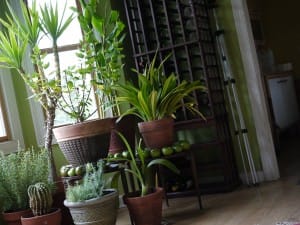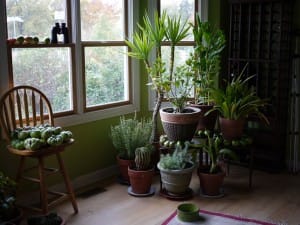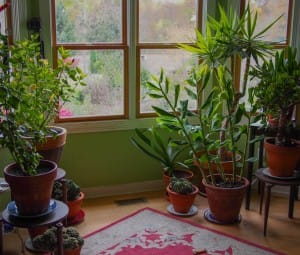Source(s): Randy Drinkard
Beautiful houseplants can add color and charm to any household. But providing the optimum growing conditions can often be a challenge for even the best of gardeners.
Low light, low humidity, dry air and too much soil moisture are the primary culprits that can weaken and destroy our indoor plants. Proper management of these growing factors, of course, is essential to your maintaining healthy, vigorous houseplants. How then, you may ask, do I know what to do to correct the problem before it is too late? That is a good question, but even inexperienced growers can look for certain danger signs that plants show when they are under stress. You can then usually tell what you are doing wrong and take corrective action to revive your plants.
Listed below are the eight most common symptoms expressed by ‘sick’ plants and help tips.
- Stems grow abnormally long; leaves become long and pale and new leaves are undersized; growth is weak or spindly: This is almost always due to insufficient light. Give your plants more light by placing them closer to a window or supply supplemental lighting via grow lights.
- Stems become soft or mushy, dark in color and rotten; lower leaves curl and wilt; soil at the top of the pot is constantly wet: Too much water is the cause. Do not water as frequently or water when the soil is dry to the touch approximately one to two inches below the surface. Sometimes the soil surface may be dry but the root zone may be saturated. Continuing to water plants that are growing in over-saturated soils will inevitably lead to root rot. Make sure that your pot’s drainage hole is not clogged and don’t let your plants sit in water-filled saucers for more than an hour.

- Wilted foliage: This can actually be caused by underwatering or overwatering. Also, excessive amounts of fertilizers can draw water from the roots, causing the plant to wilt. If the plant has a root or stem disease, this will prevent water uptake, causing the plant to wilt. Other causes of wilting are low humidity, moving shock, a sudden change in light or temperature, cold or hot drafts, high heat or frost damage.
- Defoliation: Rapid defoliation may be caused by extremes in temperature, changes in light, overwatering or underwatering and exposure to cold and disease. Gradual defoliation, as when the lower leaves turn yellow and drop, can be caused by over watering(root rot), underwatering, lack of sufficient light, low fertility or disease. Keep in mind that an occasional leaf may drop due to natural aging. . .which is normal.
- Leaves yellowed, wilted and/or mottled: This is often caused by too much water which in turn causes root rot. As mentioned earlier, do not let your plants stand in water. Yellowing may also be caused by severe insect infestations(scale or spidermites),

very low light, high temperatures or insufficient amounts of plant fertilizer. [Older plants may become pot-bound and a yellowed or wilted condition usually develops. In this case, repot to a larger container using fresh potting soil].
- Browning of leaf tips: Low humidity, excess fertilizer, water that is high in fluorine, spray damage from pesticides, unfavorable soil reaction(a high or low soil pH), air pollutants or root loss due to excessive water in the soil will cause tips to brown. Water that contains fluorine should be allowed to sit for several days before using so that the fluorine may bubble out. Simply trim away any brown tips with sharp scissors to improve the looks of your houseplants.
- Leaf edges are crinkly and brown: This is caused by low humidity. Increase humidity by grouping plants or by placing them on a bed of moistened pebbles in a tray. Misting helps, too. You may also want to consider placing a cool-vapor humidifier in your plant room to increase humidity.
- Rot at soil level: This is usually caused by over watering, yet plants that are set too deeply or a fungal or bacterial disease may be the problem. In most cases you will have to discard the plant, although you may be able to start new plants by taking cuttings from upper sections that are healthy.
Center Publication Number: 109
- Saddleback Caterpillars: Watch Out for that Sting - September 26, 2018
- Hanging Baskets - September 24, 2013
- Houseplant Help - September 24, 2013